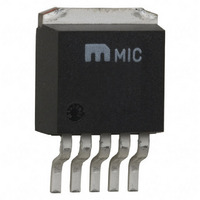MIC5237-2.5YU Micrel Inc, MIC5237-2.5YU Datasheet - Page 7

MIC5237-2.5YU
Manufacturer Part Number
MIC5237-2.5YU
Description
500mA 3% LDO Improved LM2937( )
Manufacturer
Micrel Inc
Datasheet
1.MIC5237-3.3YU.pdf
(9 pages)
Specifications of MIC5237-2.5YU
Regulator Topology
Positive Fixed
Voltage - Output
2.5V
Voltage - Input
Up to 16V
Voltage - Dropout (typical)
0.3V @ 500mA
Number Of Regulators
1
Current - Output
500mA
Operating Temperature
-40°C ~ 125°C
Mounting Type
Surface Mount
Package / Case
TO-263-3, D²Pak (3 leads + Tab), TO-263AA
Lead Free Status / RoHS Status
Lead free / RoHS Compliant
Current - Limit (min)
-
Lead Free Status / RoHS Status
Lead free / RoHS Compliant
Other names
576-2383
MIC5237-2.5YU
MIC5237-2.5YU
Application Information
The MIC5237 is intended for general-purpose use and can
be implemented in a wide variety of applications where
500mA of output current is needed. It is available in several
voltage options for ease of use. For voltage options that are
not available on the MIC5237, consult the MIC5209 for a
500mA adjustable LDO regulator, or the MIC5219 for
applications that require only short-duration peak output
current.
Input Capacitor
A 1µF capacitor should be placed from IN to GND if there is
more than 10 inches of wire between the input and the ac
filter capacitor or if a battery is used as the input.
Output Capacitor
An output capacitor is required between OUT and GND to
prevent oscillation. 1µF minimum is recommended for
standard
regulator’s transient response. The output capacitor value
may be increased without limit.
The output capacitor should have an ESR (equivalent
series resistance) of about 5Ω or less and a resonant
frequency above 1MHz. Ultra low-ESR capacitors can
cause low-amplitude oscillations and/or under-damped
transient response. Most tantalum or aluminum electrolytic
capacitors are adequate; film types will work, but are more
expensive. Since many aluminum electrolytics have
electrolytes that freeze at about –30°C, solid tantalums are
recommended for operation below –25°C.
At lower values of output current, less output capacitance is
needed for output stability. The capacitor can be reduced to
0.47µF for current below 10mA or 0.33µF for currents
below 1mA.
For 2.5V applications a 22µF output capacitor is recom-
mended to reduce startup voltage overshoot.
No-Load Stability
The MIC5237 will remain stable and in regulation with no
load (other than the internal voltage divider) unlike many
other voltage regulators. This is especially important in
CMOSRAM keep-alive applications.
Thermal Considerations
Proper thermal design can be accomplished with some
basic design criteria and some simple equations. The
following information is required to implement a regulator
design.
The regulator ground current, I
Micrel, Inc.
September 2007
V
V
I
T
I
OUT
GND
A
IN
OUT
= ambient operating temperature
applications.
= input voltage
= output current
= ground current
= output voltage
Larger
GND
, can be measured or
values
improve
the
7
read from the data sheet. Assuming the worst case
scenario is good design procedure, and the corresponding
ground current number can be obtained from the data
sheet. First, calculate the power dissipation of the device.
This example uses the MIC5237-5.0BT, a 13V input, and
500mA output current, which results in 20mA of ground
current, worst case. The power dissipation is the sum of
two power calculations: voltage drop × output current and
input voltage × ground current.
From this number, the heat sink thermal resistance is
determined using the regulator’s maximum operating
junction temperature (T
(T
calculated.
To determine the heat sink thermal resistance, the junction-
to-case thermal resistance of the device must be used
along with the case-to-heat sink thermal resistance. These
numbers show the heat-sink thermal resistance required at
T
junction temperature.
θ
3°C/W in this example.
Therefore, a heat sink with a thermal resistance of
19.5°C/W will allow the part to operate safely and it will not
exceed the maximum junction temperature of the device.
The heat sink can be reduced by limiting power dissipation,
by reducing the input voltage or output current. Either the
TO-220 or TO-263 package can operate reliably at 2W of
power dissipation without a heat sink. Above 2W, a heat
sink is recommended.
For a full discussion on voltage regulator thermal effects,
please refer to “Thermal Management” in Micrel’s
Designing with Low-Dropout Voltage Regulators handbook.
CS
A
A
) along with the power dissipation number already
=25°C that does not exceed the maximum operating
is approximately 1°C/W and θ
P
P
P
T
θ
θ
θ
θ
θ
θ
θ
θ
θ
θ
JC
CS
JA
SA
JA
SA
SA
J(MAX)
SA
D
D
D
JA
JA
= [(V
= [(13V – 5V) × 500mA] + (13V × 20mA)
= 4.260W
= junction-to-ambient thermal resistance
= 23.5°C/W
= junction-to-case thermal resistance
= sink-to-ambient thermal resistance
= 23.5°C/W – (3°C/W + 1°C/W)
= 19.5°C/W
= case-to-sink thermal resistance
= θ
=
=
= 125°C
T
125
4.260W
JA
IN
J(max)
- θ
– V
P
-
D
25
JC
OUT
-
J(max)
T
) × I
A
) and the ambient temperature
OUT
] + (V
JC
IN
× I
for the TO-220 is
M9999-090607-C
GND
)
MIC5237












